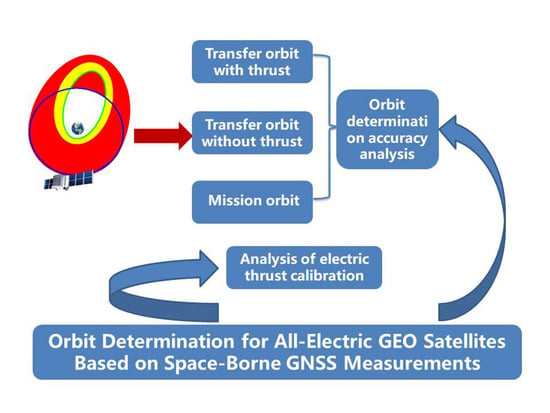Orbit Determination for All-Electric GEO Satellites Based on Space-Borne GNSS Measurements
Abstract
:1. Introduction
2. Materials and Methods
2.1. Satellite Electric Propulsion and Orbit Measurement System
- In the transfer orbit, the satellite adopts the orbit transfer control strategy, the perigee altitude is raised as soon as possible to cross the core region of the inner radiation belt in the first stage; the satellite is transferred to the mission orbit in the optimal transfer time in the second stage. The satellite thrusters are in mission state except for the ground shadow region during the satellite orbit control period.
- In the mission orbit, the satellite adopts an orbit-holding control strategy. The satellite orbit is maintained at the target geographic longitude by applying thrust control at a specific orbital phase. The satellite thrusters are operated for no more than two hours per day during the satellite orbit control period.
2.2. Orbit Determination Principle
3. Results
3.1. Analysis of Orbit Determination Accuracy of Mission Orbit
3.2. Accuracy Analysis of Non-Thrust Orbit Determination for Transfer Orbit
- (1)
- GNSS (GPS + BDS + GLONASS), single GPS, single BDS;
- (2)
- Final precision ephemeris (0.1 m), broadcast ephemeris;
- (3)
- Arc length 24 h/10 h/5 h;
- (4)
- For the arc length of 24 h, consideration that GNSS data are not continuous
3.3. Accuracy Analysis of Thrust Orbit Determination for Transfer Orbit
4. Discussion
4.1. Influence Analysis of Electric Thrust
4.2. Simulation Analysis of Electric Thrust Calibration
- (1)
- According to the initial orbit, electric thrust, and other dynamic models, the real orbit of many days is obtained, and the real acceleration time series of electric thrust is output at the same time.
- (2)
- Simulate the self-positioning data of the spaceborne GNSS receiver, add a certain random error (10/100 m) in each direction (XYZ in the Earth-fixed coordinate system), and set the data measurement extraction interval as 5 min;
- (3)
- Use the self-positioning data of a certain arc to determine the orbit and the electric thrust model parameters. The calculated electric thrust model parameters are compared with the real thrust values to evaluate the calibration accuracy of the electric thrust.
- (4)
- The attitude error in the evaluation is considered to be 0.1 degrees.
5. Conclusions
Author Contributions
Funding
Data Availability Statement
Acknowledgments
Conflicts of Interest
References
- Martinez-Sanchez, M.; Pollard, J. Spacecraft electric propulsion-an overview. J. Propuls. Power 1998, 14, 688–699. [Google Scholar] [CrossRef] [Green Version]
- Jahn, R.G. Physics of Electric Propulsion; Courier Corporation: Chelmsford, MA, USA, 2006. [Google Scholar]
- Goebel, D.; Katz, I. Fundamentals of Electric Propulsion: Ion and Hall Thrusters; John Wiley & Sons: Hoboken, NJ, USA, 2008. [Google Scholar]
- O’Reilly, D.; Herdrich, G.; Kavanagh, D. Electric propulsion methods for small satellites: A review. Aerospace 2021, 8, 22. [Google Scholar] [CrossRef]
- Duan, C.; Chen, L. Research and Inspiration of All-electric Propulsion Technology for GEO Satellites. Spacecr. Eng. 2013, 22, 99–104. [Google Scholar]
- Duchemin, O.; Caratge, A.; Cornu, N.; Sannino, J.M.; Lorand, A. Ariane 5-ME and electric propulsion: GEO insertion options. In Proceedings of the 47th AIAA/ASME/SAE/ASEE Joint Propulsion Conference & Exhibit, San Diego, CA, USA, 31 July–3 August 2011; p. 6084. [Google Scholar]
- Yu, D.; Qiao, L.; Jiang, W.; Liu, H. Development and prospect of electric propulsion technology in China. J. Propuls. Technol. 2020, 41, 1–11. [Google Scholar]
- Tang, Z.; Zhou, C.; Han, D.; Ma, X.; Chen, T. Study on high power all-electric propulsion system for spacecraft orbit transfer. J. Deep. Space Explor. 2018, 5, 367–373. [Google Scholar]
- Hu, Y.; Mao, W.; Li, D.; Wei, L.; Wei, Y. The hall propulsion technology oriented all-electric-propulsion satellites. Aerosp. Control Appl. 2017, 43, 73–78. [Google Scholar]
- Wei, B.; Sun, X.; Wang, X. The Review of All-Electric Propulsion Platform on Satellite. Vac. Cryog. 2016, 22, 301–305+310. [Google Scholar]
- Yang, D. Research on Key Technologies of Orbit Design and Control for All Electric Satellite; Nanjing University of Aeronautics and Astronautics: Nanjing, China, 2016. [Google Scholar]
- Hu, Z.; Wang, M.; Yuan, J. A review of the development of all-electric propulsion platform in the world. Spacecr. Environ. Eng. 2015, 32, 566–570. [Google Scholar]
- Zuo, K.; Wang, M.; Li, M.; Tang, H. Research overview of commercial satellite platform with all-electric propulsion system. J. Rocket. Propuls. 2015, 41, 13–20. [Google Scholar]
- Sun, X.; Zhang, T.; Wang, X.; Wang, L.; Liu, M. The Research of Electric Propulsion’s Application of Electric Propulsion Satellite Platform. Vac. Cryog. 2015, 21, 6–10. [Google Scholar]
- Nishi, K.; Ozawa, S.; Matunaga, S. Design and guidance for robust orbit raising trajectory of all-electric propulsion geostationary satellites. Trans. Jpn. Soc. Aeronaut. Space Sci. Aerosp. Technol. Jpn. 2021, 19, 553–561. [Google Scholar] [CrossRef]
- Jin, G.; Kang, L. Design of Hall Electric Propulsion System in “Tianhe” Core Module. Aerosp. China 2021, 8, 22–27. [Google Scholar]
- Chen, M.; Liu, X.; Zhou, H.; Chen, C.; Jia, H. Research and development of micro electric propulsion technology for micro/nano satellites. J. Solid Rocket. Technol. 2021, 44, 188–206. [Google Scholar]
- Yang, F.; Wang, C.; Hu, J.; Zhang, H.; Wu, C.; Zhang, X.; Geng, H.; Fu, D. Technical project of ion propulsion for satellites in super low Earth orbit. Chin. Space Sci. Technol. 2021, 41, 52–59. [Google Scholar]
- Wang, Z.; Zhang, T.; Peng, K. Design of Electric Propulsion System for Ground-month Single-ship Cargo Ship. Vac. Cryog. 2020, 26, 317–322. [Google Scholar]
- Wang, S.; Xiong, S. Research on transfer orbit based on electric propulsion satellite to halo orbit. Chin. J. Space Sci. 2019, 39, 489–493. [Google Scholar]
- Ren, Y.; Wang, X. Development of High-performances Electric Propulsion System and the Application on GEO Satellite Platforms. Vac. Cryog. 2018, 24, 60–65. [Google Scholar]
- Kuai, Z. Research on Station Keeping and Orbital Transfer of Geostationary Satellites by Impulse and Electric Propulsion; University of Science and Technology of China: Hefei, China, 2017. [Google Scholar]
- Tian, B.; Xue, D.; Huang, M. Orbit Transfer Strategies for GEO Satellites Using All-electric Propulsion. Spacecr. Eng. 2015, 24, 7–13. [Google Scholar]
- Li, S. The Research on the Application of Electrical Propulsion Technology in GEO Satellite Orbit Control; National University of Defense Technology: Changsha, China, 2015. [Google Scholar]
- Feuerborn, S.A.; Perkins, J.; Neary, D.A. Finding a way: Boeing’s all electric propulsion satellite. In Proceedings of the 49th AIAA/ASME/SAE/ASEE Joint Propulsion Conference, San Jose, CA, USA, 14–17 July 2013; p. 4126. [Google Scholar]
- Casaregola1, C. Electric Propulsion for Station Keeping and Electric Orbit Raising on Eutelsat Platforms. In Proceedings of the Japan International Electric Propulsion Conference, Kobe, Japan, 4–10 July 2015. [Google Scholar]
- Zhou, Z.; Gao, J. Development Approach to All-Electric Propulsion GEO Satellite Platform. Spacecr. Eng. 2015, 24, 1–6. [Google Scholar]
- Zhang, T. The LIPS-200 Ion Electric Propulsion System Development for the DFH-3B Satellite Platform. In Proceedings of the 64th International Astronautical Congress, Beijing, China, 23–27 September 2013. [Google Scholar]
- Zhang, T. Initial Flight Test Results of the LIPS-200 Electric Propulsion System on SJ-9A Satellite. In Proceedings of the International Electric Propulsion Conference, Washington, DC, USA, 6–10 October 2013. [Google Scholar]
- Zhang, T. New progress of electric propulsion technology in LIP. J. Rocket. Propuls. 2015, 41, 7–12. [Google Scholar]
- Wen, Z.; Shi, M.; Geng, H.; Zhang, W.; Li, Z. Application and Fight Testing of Ion Electric Propulsion in High Throughout Satellite. Vac. Cryog. 2022, 28, 79–86. [Google Scholar]
- Wang, H.; Li, G.; Shi, B.; Zhang, J.; Jiang, G.; Shen, Y.; Wu, G. Orbit Transfer Method of All-electric Propulsion SmallGEO Satellite Based on GNSS. Radio Commun. Technol. 2020, 46, 527–533. [Google Scholar]
- Hofmann-Wellenhof, B.; Lichtenegger, H.; Wasle, E. GNSS–Global Navigation Satellite Systems: GPS, GLONASS, Galileo, and More; Springer: Berlin, Germany, 2007. [Google Scholar]
- Groves, P. Principles of GNSS, inertial, and multisensor integrated navigation systems. IEEE Aerosp. Electron. Syst. Mag. 2015, 30, 26–27. [Google Scholar] [CrossRef]
- Li, X.; Ge, M.; Dai, X.; Ren, X.; Fritsche, M.; Wickert, J.; Schuh, H. Accuracy and reliability of multi-GNSS real-time precise positioning: GPS, GLONASS, BeiDou, and Galileo. J. Geod. 2015, 89, 607–635. [Google Scholar] [CrossRef]
- Zhou, X.; Wang, X.; Zhao, G.; Peng, H.; Wu, B. The precise orbit determination for hy2a satellite using GPS, DORIS and SLR data. Geomat. Inf. Sci. Wuhan Univ. 2015, 40, 1000. [Google Scholar]
- Gong, X.; Wang, F. Autonomous orbit determination of hy2a and zy3 missions using space-borne GPS measurements. Geomat. Inf. Sci. Wuhan Univ. 2017, 42, 309–313. [Google Scholar]
- Yuan, J.; Zhao, C.; Wu, Q. Phase center offset and phase center variation estimation in-flight for zy-3 01and zy-3 02spaceborne GPS antennas and the influence on precision orbit determination. Acta Geod. et Cartogr. Sin. 2018, 47, 672–682. [Google Scholar]
- Li, M.; Li, W.; Shi, C.; Jiang, K.; Guo, X.; Dai, X.; Meng, X.; Yang, Z.; Yang, G.; Liao, M. Precise orbit determination of the Fengyun-3C satellite using onboard GPS and BDS observations. J. Geod. 2017, 91, 1313–1327. [Google Scholar] [CrossRef] [Green Version]
- Li, W.; Li, M.; Zhao, Q.; Shi, C.; Guo, X.; Meng, X.; Yang, Z. FY3C Satellite Onboard BDS and GPS Data Quality Evaluation and Precise Orbit Determination. Acta Geod. et Cartogr. Sin. 2018, 47, 9–17. [Google Scholar]
- Zhao, X.; Zhou, S.; Ci, Y.; Hu, X.; Cao, J.; Chang, Z.; Tang, C.; Guo, D.; Guo, K.; Liao, M. High-precision orbit determination for a LEO nanosatellite using BDS-3. GPS Solut. 2020, 24, 102. [Google Scholar] [CrossRef]
- Powell, T.; Martzen, P.; Sedlacek, S.; Chao, C.-C.; Silva, R. GPS Signals in a Geosynchronous Transfer Orbit:“Falcon Gold” Data Processing. In Proceedings of the 1999 National Technical Meeting of the Institute of Navigation, San Diego, CA, USA, 25–27 January 1999; pp. 575–585. [Google Scholar]
- Bauer, F.; Moreau, M.; Davis, E.; Carpenter, J.; Kelbel, D.; Davis, G.; Axelrad, P. Results from the GPS flight experiment on the high earth orbit amsat oscar-40 spacecraft. In Proceedings of the 15th International Technical Meeting of the Satellite Division of the Institute of Navigation, Portland, OR, USA, 24–27 September 2002. [Google Scholar]
- Unwin, M.; Blunt, P.; de Vos van Steenwijk, R. Navigating above the GPS constellation—Preliminary results from the SGR-GEO on GIOVE-A. In Proceedings of the 26th International Technical Meeting of the Satellite Division of the Institute of Navigation, Nashville, TN, USA, 16–20 September 2013. [Google Scholar]
- Barker, L.; Frey, C. GPS at GEO: A first look at GPS from SBIRS GEO. Adv. Astronaut. Sci. 2012, 144, 199–212. [Google Scholar]
- Fan, M.; Hu, X.; Dong, G.; Huang, Y.; Cao, J.; Tang, C.; Li, P.; Shengqi, C.; Yu, Y. Orbit improvement for Chang’e-5T lunar returning probe with GNSS technique. Adv. Space Res. 2015, 56, 2473–2482. [Google Scholar] [CrossRef]
- Wang, M.; Shan, T.; Ma, L.; Tao, R.; Chen, C. Performance of GPS and GPS/SINS navigation in the CE-5T1 skip re-entry mission. GPS Solut. 2018, 22, 1–12. [Google Scholar] [CrossRef]
- Wang, M.; Shan, T.; Wang, D. Development of GNSS technology for high earth orbit spacecraft. Acta Geod. et Cartogr. Sin. 2020, 49, 1158–1167. [Google Scholar]
- Li, B.; Liu, L.; Wang, M. Performance demonstration and analysis of GNSS navigation in geo satellites. Aerosp. Shanghai 2017, 34, 133–143. [Google Scholar]
- Jiang, K.; Min, L.; Wang, M.; Zhao, Q.; Li, W. Tjs-2 geostationary satellite orbit determination using onboard GPS measurements. GPS Solut. 2018, 22, 1–14. [Google Scholar] [CrossRef]
- Zhu, J.; Wang, C.; He, Y.; Yang, Y. High Accuracy Navigation for Geostationary Satellite TTS-II via Space-borne GPS. In Proceedings of the 39th Chinese Control Conference, Shenyang, China, 27–30 July 2020; pp. 3362–3367. [Google Scholar]
- Winternitz, L.; Bamford, W.; Heckler, G. A GPS receiver for high-altitude satellite navigation. Selected Topics in Signal Processing. IEEE J. 2009, 3, 541–556. [Google Scholar]
- Han, M.; Wang, Y. Optimization method for orbit transfer of all-electric propulsion satellite based on reinforcement learning. Syst. Eng. Electron. 2022, 44, 1652–1661. [Google Scholar]
- Duan, C.; Ren, L.; Chang, Y.; Bai, Q.; An, R.; Huang, Y. All-electric propulsion satellite trajectory optimization by homotopic approach. Chin. Space Sci. Technol. 2020, 40, 42–48. [Google Scholar]
- Wang, M.; Li, Q.; Liang, X.; An, R. Low-Thrust Orbit Transfer Strategy On-Board Computation for All Electric Propulsion Satellite. J. Propuls. Technol. 2020, 41, 180–186. [Google Scholar]
- Cui, Z.; Zhou, L.; Hu, S.; Gong, J. An electric thrust vector calibrating algorithm using angular momentum. Chin. Space Sci. Technol. 2019, 39, 1–8. [Google Scholar]
- Li, H.; Topputo, F.; Baoyin, H. Autonomous time-optimal many-revolution orbit raising for electric propulsion geo satellites via neural networks. arXiv 2019, arXiv:1909.08768. [Google Scholar]
- Montenbruck, O.; Gill, E. Satellite Orbits; Springer: Berlin/Heidelberg, Germany, 2000. [Google Scholar]
- Wu, Z. Researches on Precise Orbit Determination Based GNSS and Its Application; University of Chinese Academy Sciences: Beijing, China, 2018. [Google Scholar]
- Fan, M. Researches of GNSS-Based Navigation for Lunar Missions; University of Chinese Academy Sciences: Beijing, China, 2017. [Google Scholar]
- Zhu, J.; Wang, J.; Chen, J.; He, Y. Centimeter precise orbit determination for HY-2 via DORIS. J. Astronaut. 2013, 34, 163–169. [Google Scholar]
- Montenbruck, O.; Helleputte, T.; Kroes, R.; Gill, E. Reduced Dynamic Orbit Determination using GPS Code and Carrier Measurements. Aerosp. Sci. Technol. 2005, 9, 261–271. [Google Scholar] [CrossRef]
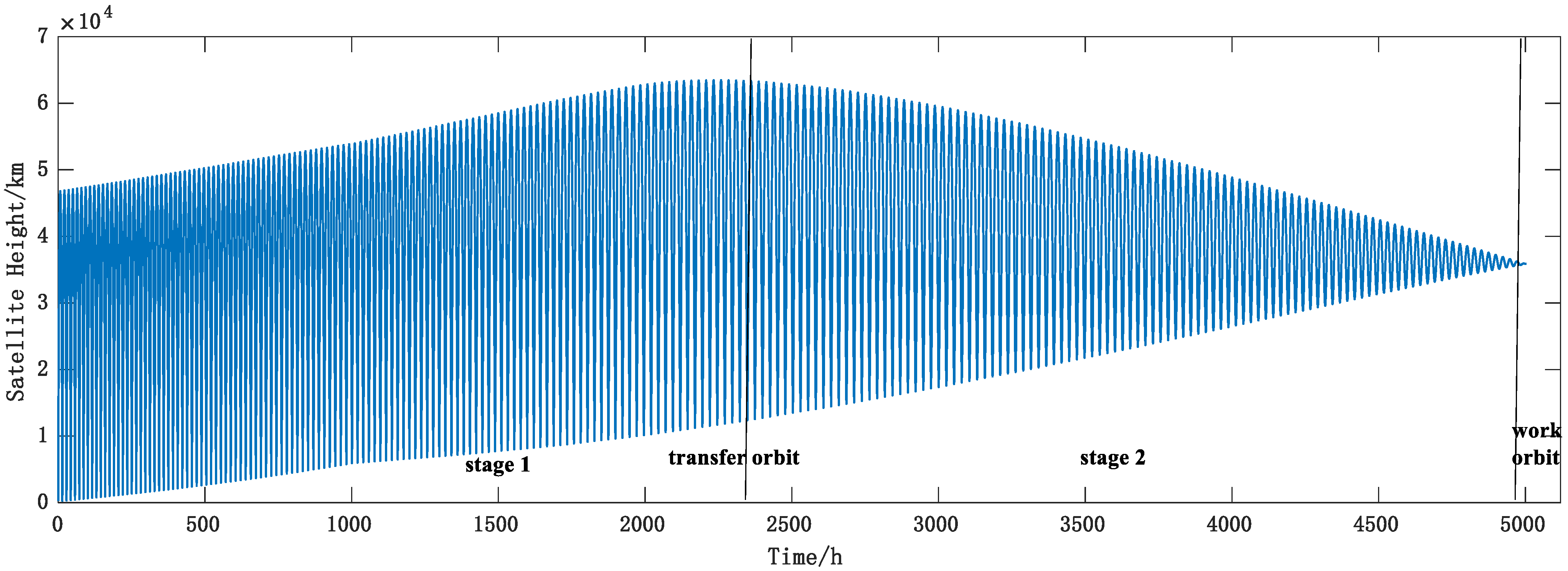
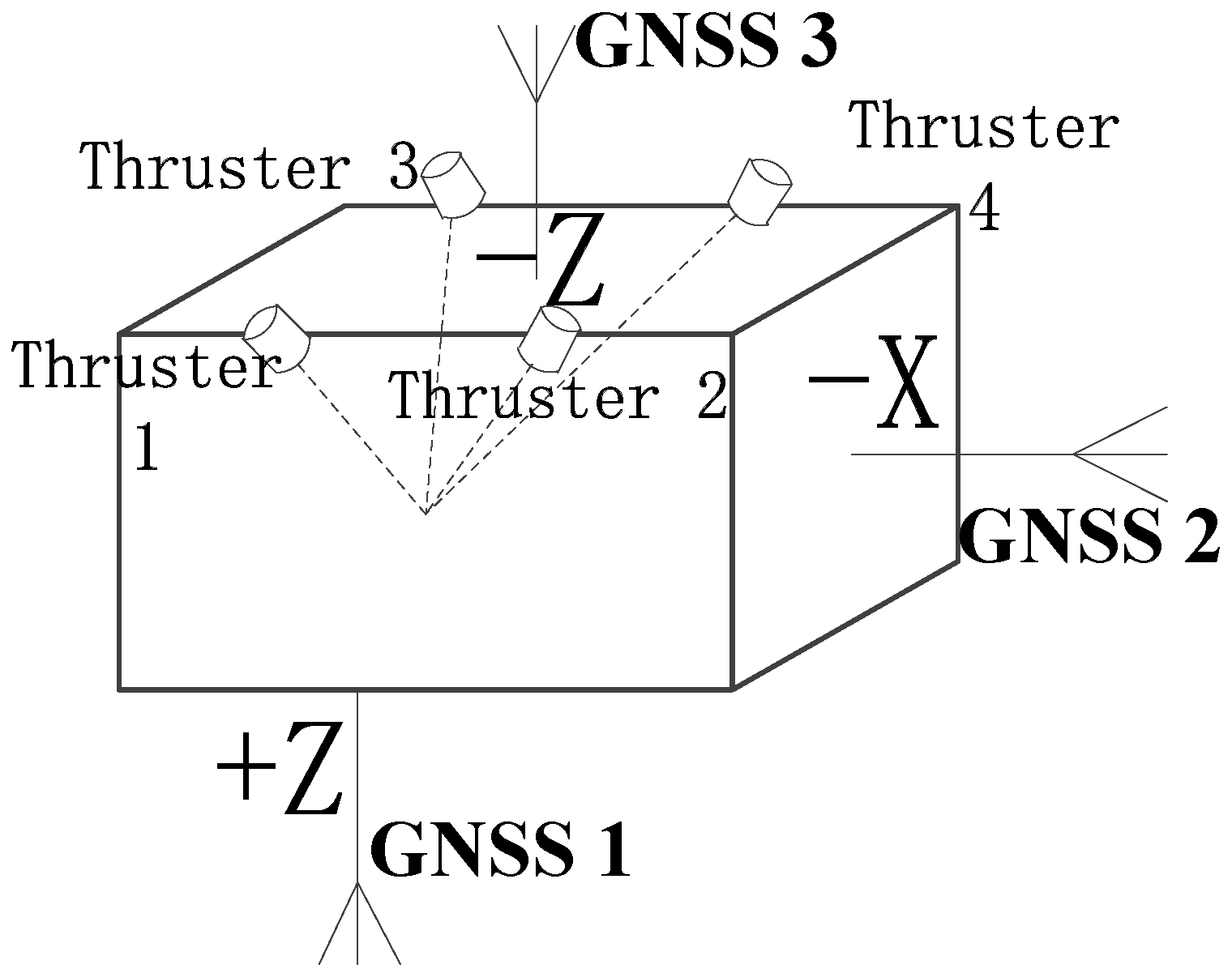


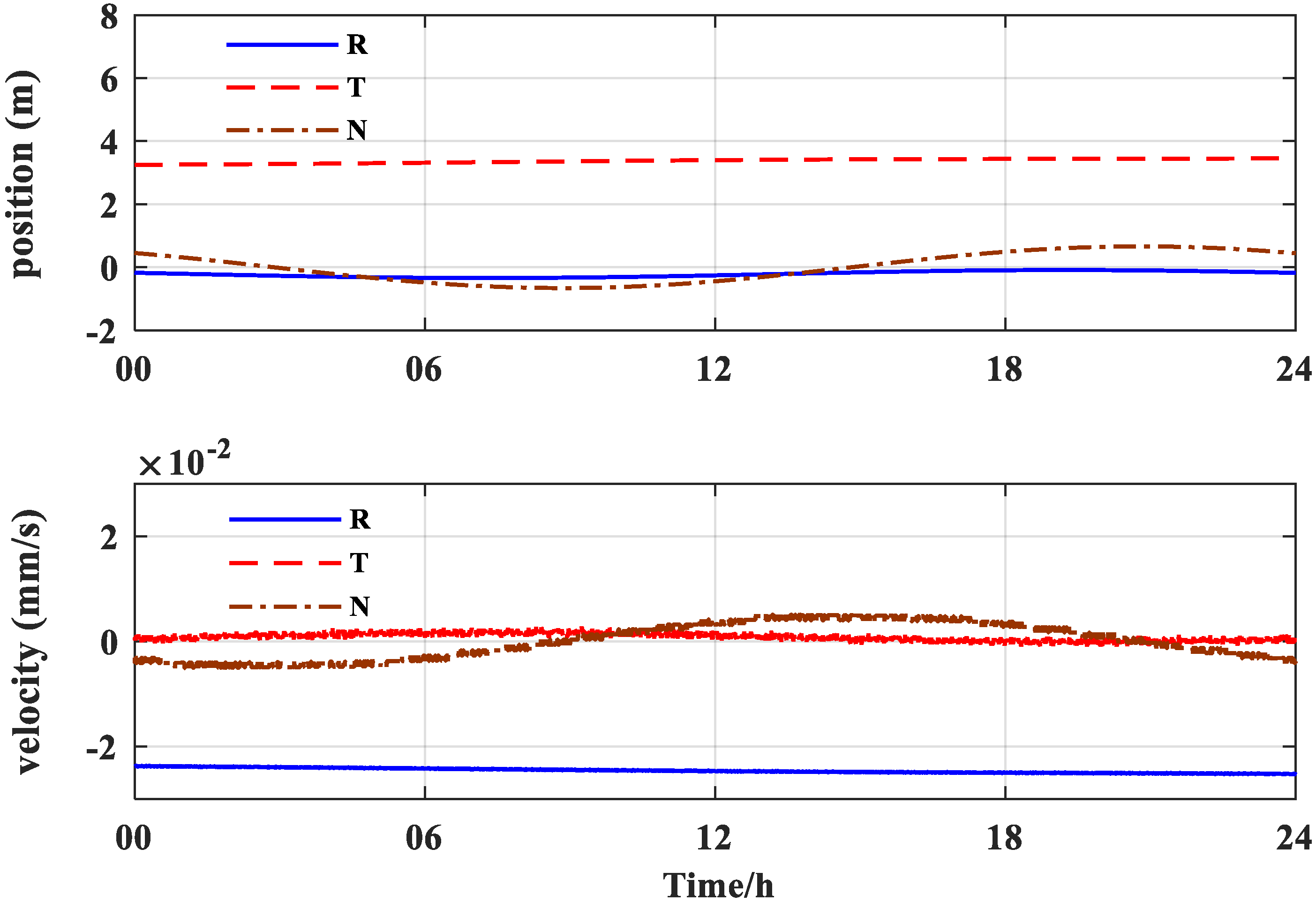

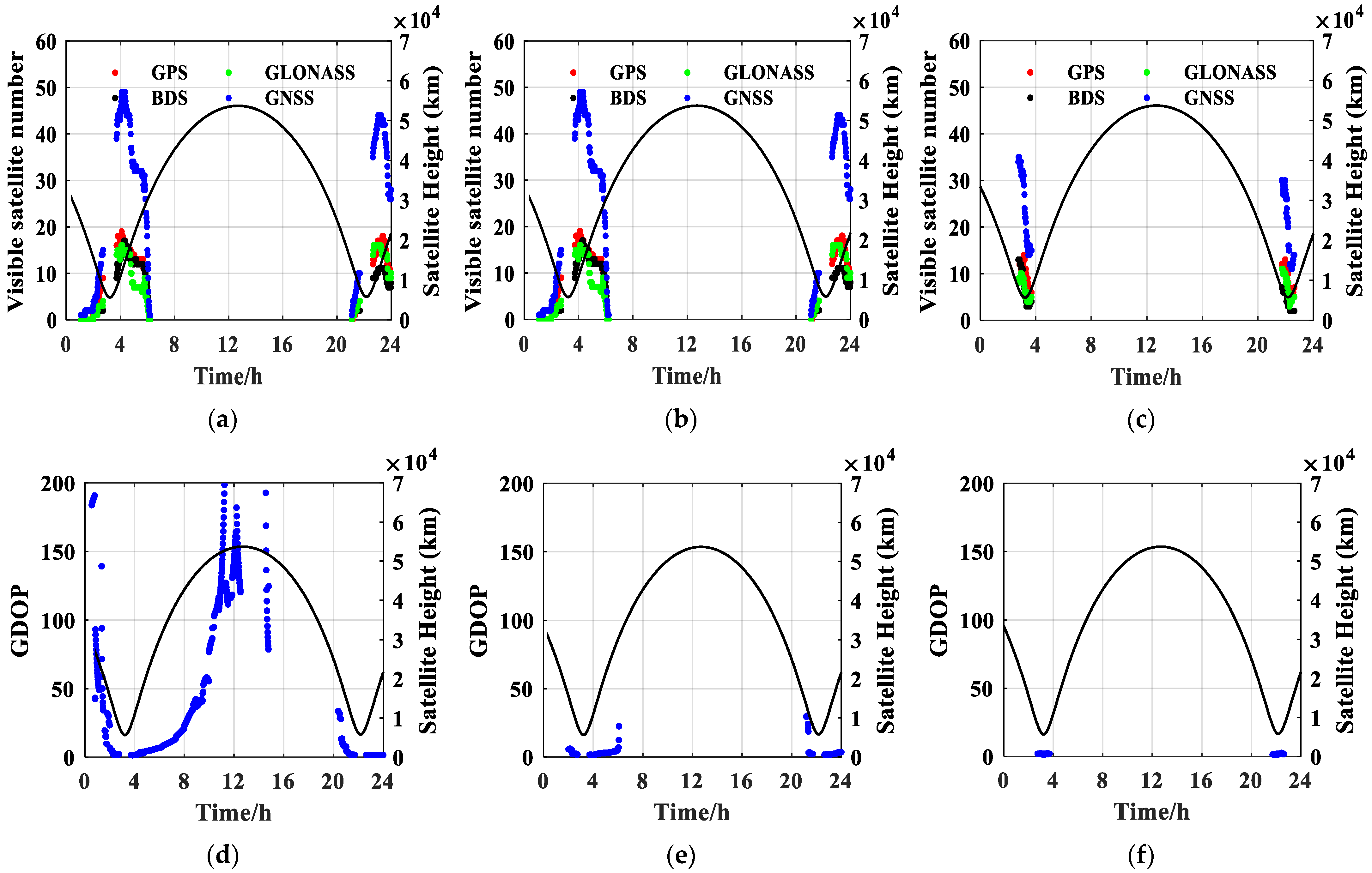
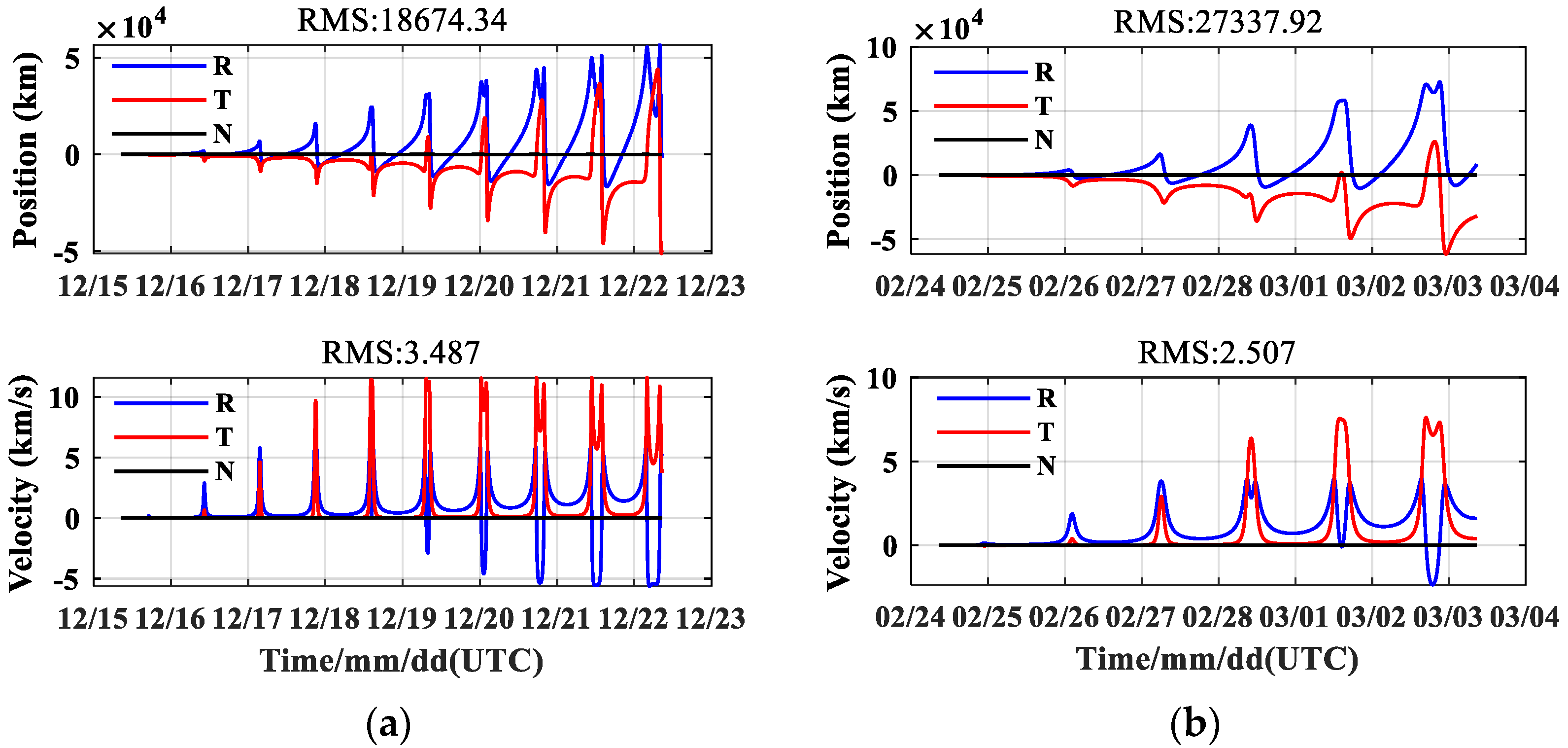
| Type | Indicators |
|---|---|
| Operating frequency | GPS L1/GLONASS L1/BDS B1 |
| Time accuracy | <5 us |
| Pseudo-Range Measurement Accuracy (RMS) | <1 m (height < 1000 km), <10 m (height < 36,000 km) |
| Carrier Phase Accuracy (RMS) | <5 mm (height < 1000 km), <3 cm (height < 36,000 km) |
| Measurement extraction interval | 5 min |
| Type | PRN | NUM |
|---|---|---|
| GPS | G01~G32 (except G04/G19) | 30 |
| GLONASS | R01~R24 (except R06/R12) | 22 |
| BDS | C01~C37 (except C15/C16/C17/C18/C20/C28/C30/C31) | 29 |
| Type | Value |
|---|---|
| Arc length | 24 h |
| Measurement extraction interval | 5 min |
| Pseudorange noise (RMS) | 10 m |
| Phase noise (RMS) | 0.03 m |
| GNSS satellite ephemeris | MGEX-WHU |
| GNSS satellite clock difference | MGEX-WHU |
| Earth gravity field | EIGEN_GL04C (100 100) |
| N body | DE421 |
| Solid tide | IERS 2003 |
| Sea tide | FES2004 |
| Solar radiation pressure | Fixed surface-to-mass ratio model |
| Model | Describe |
|---|---|
| Arc length | 24 h |
| Measurement extraction interval | 5 min |
| Pseudorange noise (RMS) | 10 m |
| Phase noise (RMS) | 0.03 m |
| Earth gravity field | EIGEN_GL04C (100 100) |
| N body | DE421 |
| Solid tide | IERS 2003 |
| Sea tide | FES2004 |
| Solar radiation pressure | Fixed surface-to-mass ratio model |
| Estimated parameters | Satellite initial state (position, velocity) receiver clock error, phase ambiguity |
| Observation data weights | The weight ratio of code observation to phase observation is 1/100 |
| GNSS navigation satellite ephemeris | Precision ephemeris (add 0.1 m position error) |
| Model Errors | POD Accuracy (m) | ||
|---|---|---|---|
| Observation data | Pseudorange noise (6 m) | 0.15 | |
| 5 h arc length | 1.19 | ||
| Pseudorange only | 1.2 | ||
| GNSS navigation satellite ephemeris | GPS only | 0.27 | |
| Precision ephemeris (add 1 m position error) | 1.34 | ||
| Dynamics model | Earth gravity field | 5 5 | 0.24 |
| 3 3 | 0.44 | ||
| 2 2 | 5.66 | ||
| Solar radiation pressure | 5% error | 0.66 | |
| 10% error | 1.32 | ||
| Navigation System | Ephemeris | Arc Length | Orbit Determination Accuracy (m) | 14-Day Prediction Accuracy (m) |
|---|---|---|---|---|
| GNSS (GPS + BDS + GLONASS) | Final precision ephemeris (0.1 m error) | 24 h continuous | 1.56 | 272.29 |
| 24 h discontinuity | 1.94 | 628.6 | ||
| 10 h | 0.97 | 552.75 | ||
| 5 h | 1.4 | 858.84 | ||
| Broadcast ephemeris | 24 h continuous | 5.03 | 396.87 | |
| 24 h discontinuity | 6.19 | 928.49 | ||
| 10 h | 5.02 | 1213.25 | ||
| 5 h | 5.43 | 3147.11 | ||
| GPS | Final precision ephemeris (0.1 m error) | 24 h continuous | 1.89 | 411.81 |
| 24 h discontinuity | 1 | 561.61 | ||
| 10 h | 0.59 | 667.52 | ||
| 5 h | 0.85 | 743.44 | ||
| Broadcast ephemeris | 24 h continuous | 4.86 | 477.74 | |
| 24 h discontinuity | 4.61 | 685.85 | ||
| 10 h | 4.35 | 1369.57 | ||
| 5 h | 5.23 | 2061.98 | ||
| BDS | Final precision ephemeris (0.1 m error) | 24 h continuous | 1.94 | 253.21 |
| 24 h discontinuity | 2.96 | 469.1 | ||
| 10 h | 1.37 | 834.45 | ||
| 5 h | 1.96 | 997.81 | ||
| Broadcast ephemeris | 24 h continuous | 5.3 | 303.39 | |
| 24 h discontinuity | 5.92 | 747.34 | ||
| 10 h | 7.07 | 692.47 | ||
| 5 h | 5.23 | 2521.03 |
| Empirical Force Processing Strategy | Orbit Determination Accuracy (m) | 10 h Prediction Accuracy (km) |
|---|---|---|
| Solve | 712 | 300 |
| Fix after solving | 709 | 20 |
| Self-Positioning Data Error (m) | Arc Length (hours) | 14-Day Prediction Accuracy (km) | Calibration Accuracy (m/s2) |
|---|---|---|---|
| 10 | 16 | 20 | 1.2 d−08 |
| 10 | 40 | 1 | 1.9 d−10 |
| 100 | 16 | 200 | 1.2 d−07 |
| 100 | 40 | 4 | 1.9 d−9 |
Publisher’s Note: MDPI stays neutral with regard to jurisdictional claims in published maps and institutional affiliations. |
© 2022 by the authors. Licensee MDPI, Basel, Switzerland. This article is an open access article distributed under the terms and conditions of the Creative Commons Attribution (CC BY) license (https://creativecommons.org/licenses/by/4.0/).
Share and Cite
Lu, W.; Wang, H.; Wu, G.; Huang, Y. Orbit Determination for All-Electric GEO Satellites Based on Space-Borne GNSS Measurements. Remote Sens. 2022, 14, 2627. https://doi.org/10.3390/rs14112627
Lu W, Wang H, Wu G, Huang Y. Orbit Determination for All-Electric GEO Satellites Based on Space-Borne GNSS Measurements. Remote Sensing. 2022; 14(11):2627. https://doi.org/10.3390/rs14112627
Chicago/Turabian StyleLu, Wenqiang, Haoguang Wang, Guoqiang Wu, and Yong Huang. 2022. "Orbit Determination for All-Electric GEO Satellites Based on Space-Borne GNSS Measurements" Remote Sensing 14, no. 11: 2627. https://doi.org/10.3390/rs14112627
APA StyleLu, W., Wang, H., Wu, G., & Huang, Y. (2022). Orbit Determination for All-Electric GEO Satellites Based on Space-Borne GNSS Measurements. Remote Sensing, 14(11), 2627. https://doi.org/10.3390/rs14112627





